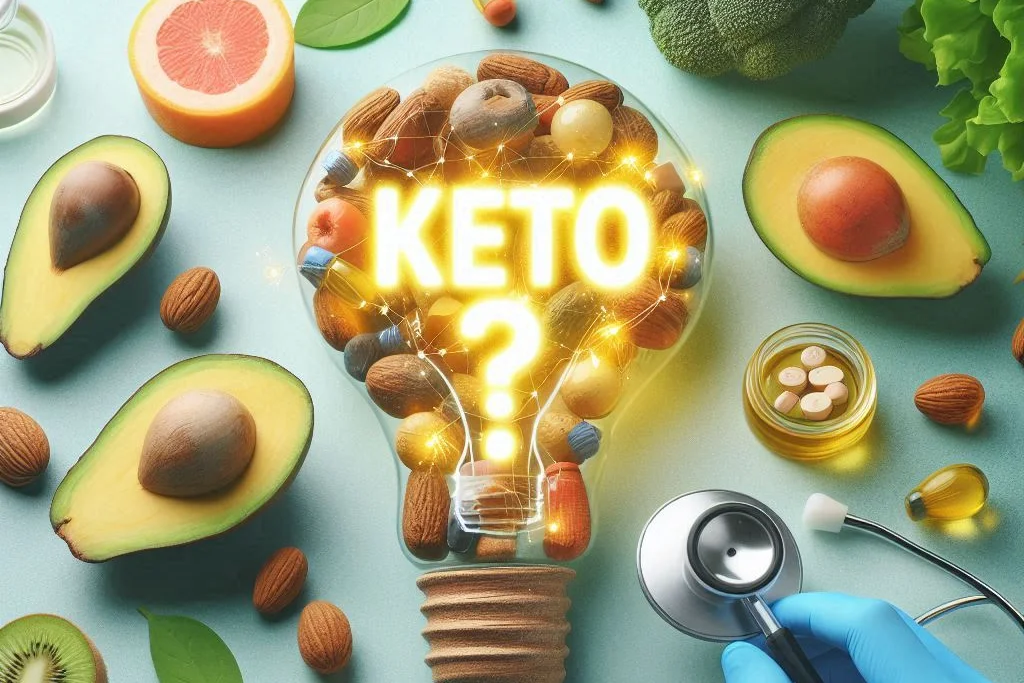Diet Guide – Keto Diet
Curious about how the keto diet can transform health? Check out this article to learn about benefits, risks, and tips!

This article is part of a series. Check them out all!
In the realm of weight management strategies, low-carbohydrate, high-protein meal plans frequently attract attention. Examples such as the Paleo, South Beach, and Atkins diets fall into this category. These are sometimes grouped under the umbrella of ketogenic or “keto” diets. However, a genuine ketogenic approach differs significantly. Rather than emphasizing protein, this regimen is centered on fat, which may provide up to 90% of daily caloric intake. This is not considered a diet suitable for casual experimentation.
Traditionally, the ketogenic diet has been implemented to assist in reducing the frequency of epileptic seizures in pediatric cases. Although it has been explored for weight loss purposes, it is generally advised that such an approach be adopted only as a short-term adjustment to initiate weight reduction.
How does the ketogenic diet function?
At its core, the ketogenic approach is designed to shift the body’s primary energy source. Rather than depending on glucose derived from carbohydrates—found in foods such as grains, legumes, vegetables, and fruits—this dietary method promotes reliance on ketone bodies. These are energy compounds produced by the liver through the breakdown of stored fat.
While the process of burning fat may appear to be a favorable method for weight management, the transition into ketosis presents certain challenges.
What is ketosis?
Ketosis refers to a metabolic condition in which fat becomes the primary energy source in place of carbohydrates. This state is typically initiated when carbohydrate intake is significantly reduced, thereby limiting the body’s access to glucose—the preferred fuel for cellular activity.
Adherence to a ketogenic dietary pattern is recognized as the most effective method for reaching ketosis. This generally includes restricting carbohydrate intake to approximately 20 to 50 grams per day while emphasizing fat-rich foods such as meat, fish, eggs, nuts, and certain plant-based oils.
Moderation in protein consumption is also advised, as excessive protein intake may lead to the conversion of amino acids into glucose, potentially delaying the onset of ketosis.
The practice of intermittent fasting has also been associated with a more rapid transition into ketosis. A common approach includes limiting food consumption to an eight-hour window, followed by a fasting period of sixteen hours.
Ketone levels—an indicator of ketosis—can be measured through blood, urine, or breath testing. Additionally, certain physical signs may be observed during the onset of ketosis, including increased thirst, dryness in the mouth, more frequent urination, and a noticeable reduction in appetite.

What is consumed?
Due to the elevated fat requirements of the ketogenic diet, fat is included in every meal. Within a 2,000-calorie framework, intake may approximate 165 grams of fat, 40 grams of carbohydrates, and 75 grams of protein. However, the precise balance is typically tailored to individual metabolic needs and health goals.
A variety of unsaturated fats are permitted, including sources such as nuts (almonds, walnuts), seeds, avocados, tofu, and olive oil. In addition, higher quantities of saturated fats—found in coconut oil, palm oil, lard, butter, and cocoa butter—are commonly encouraged.
Protein intake forms a component of this dietary plan, though it often does not differentiate between lean options and those rich in saturated fats, including items like beef, pork, and bacon.
Regarding fruits and vegetables, carbohydrate content plays a significant role in determining suitability. Most fruits are high in carbohydrates, though limited portions of select options, typically berries, may be included. Vegetable selection is generally confined to those lower in carbohydrates, such as leafy greens (kale, Swiss chard, spinach), cauliflower, broccoli, Brussels sprouts, asparagus, bell peppers, onions, garlic, mushrooms, cucumber, celery, and summer squashes. For example, a cup of chopped broccoli contains approximately six grams of carbohydrates.
A one-week example of a ketogenic meal plan
The following sample outlines a ketogenic approach to daily meals across a seven-day period:
| day | meal | description | protein_g | carbs_g | fat_g | calories |
| Monday | Breakfast | Veggie and egg muffins with tomatoes | 18 | 6 | 22 | 300 |
| Monday | Lunch | Chicken salad with olive oil, feta cheese, olives, and side salad | 28 | 8 | 35 | 450 |
| Monday | Dinner | Salmon with asparagus cooked in butter | 30 | 4 | 38 | 480 |
| Tuesday | Breakfast | Egg, tomato, basil, and spinach omelet | 20 | 5 | 25 | 320 |
| Tuesday | Lunch | Keto smoothie and sliced strawberries | 15 | 10 | 20 | 280 |
| Tuesday | Dinner | Cheese-shell tacos with salsa | 25 | 6 | 32 | 410 |
| Wednesday | Breakfast | Nut milk chia pudding with coconut and blackberries | 12 | 8 | 24 | 300 |
| Wednesday | Lunch | Avocado shrimp salad | 22 | 5 | 30 | 400 |
| Wednesday | Dinner | Pork chops with Parmesan cheese, broccoli, and salad | 28 | 7 | 34 | 460 |
| Thursday | Breakfast | Omelet with avocado, salsa, peppers, onion, spices | 18 | 6 | 26 | 350 |
| Thursday | Lunch | Nuts and celery with guacamole and salsa | 10 | 8 | 28 | 300 |
| Thursday | Dinner | Chicken stuffed with pesto and cream cheese, grilled zucchini | 26 | 5 | 36 | 450 |
| Friday | Breakfast | Greek yogurt with peanut butter, cocoa, berries | 16 | 9 | 22 | 320 |
| Friday | Lunch | Ground beef lettuce wrap tacos with bell peppers | 24 | 6 | 30 | 410 |
| Friday | Dinner | Loaded cauliflower and mixed veggies | 14 | 8 | 28 | 350 |
| Saturday | Breakfast | Cream cheese pancakes with blueberries, mushrooms | 16 | 7 | 26 | 340 |
| Saturday | Lunch | Zucchini and beet noodle salad | 10 | 10 | 20 | 280 |
| Saturday | Dinner | White fish in olive oil with kale and pine nuts | 28 | 5 | 34 | 430 |
| Sunday | Breakfast | Fried eggs with mushrooms | 14 | 3 | 22 | 290 |
| Sunday | Lunch | Sesame chicken and broccoli | 26 | 6 | 28 | 420 |
| Sunday | Dinner | Spaghetti squash Bolognese | 20 | 9 | 24 | 360 |
Keto-friendly food intake depends on the specific variation of the ketogenic plan being followed. Several forms exist, each with its own macronutrient focus:
- Standard ketogenic diet (SKD): Characterized by very low carbohydrate intake, moderate protein levels, and high fat content. Typical macronutrient distribution includes approximately 70% fat, 20% protein, and 10% carbohydrates.
- Cyclical ketogenic diet (CKD): Structured to include periods of increased carbohydrate intake, often practiced as five consecutive ketogenic days followed by two higher-carbohydrate days.
- Targeted ketogenic diet (TKD): Designed to permit the inclusion of carbohydrates specifically around periods of physical activity.
- High protein ketogenic diet: A variation of the standard approach that incorporates higher protein content. Common ratios involve around 60% fat, 35% protein, and 5% carbohydrates.
Among these, the standard and high protein ketogenic diets have received the most thorough scientific examination. In contrast, the cyclical and targeted approaches are typically considered more specialized and are primarily utilized by those engaged in high-performance physical training, such as athletes and bodybuilders.
The primary guidance presented here reflects the standard ketogenic diet, although core concepts may also apply to the other variations.

Keto diet risks
Several risks have been associated with the ketogenic diet. A primary concern lies in its high content of saturated fat. It has been advised by health experts that saturated fats be limited to no more than 7% of total daily caloric intake, due to established links with cardiovascular disease. Additionally, this dietary pattern has been linked to elevated levels of LDL cholesterol, commonly referred to as “bad” cholesterol, which is another factor in heart disease risk.
Other potential concerns include
- Nutrient deficiencies.
Without a diverse intake of vegetables, fruits, and whole grains, the possibility of deficiencies in essential micronutrients—such as selenium, magnesium, phosphorus, and vitamins B and C—may increase. - Liver strain.
The high fat intake required by this diet may place additional burden on the liver, potentially worsening pre-existing liver conditions. - Kidney stress.
Since protein metabolism involves kidney function, elevated protein intake may challenge renal health. Current general guidelines suggest an average protein intake of 46 grams per day for women and 56 grams per day for men. - Constipation.
A reduced intake of fiber-rich foods, including grains and legumes, may contribute to digestive irregularities. - Cognitive and mood effects.
The brain typically functions optimally when fueled by glucose derived from healthy carbohydrate sources. When carbohydrate intake is restricted, difficulties such as mental fog and mood fluctuations may occur. - Low protein levels in the blood
- Individuals taking sodium-glucose cotransporter 2 (SGLT2) inhibitors for type 2 diabetes may face an increased risk of diabetic ketoacidosis, a condition that raises blood acidity and can be dangerous. The keto diet should be avoided by those on this medication.
Due to the cumulative nature of these risks, consultation with a qualified healthcare provider and a registered dietitian is strongly recommended before initiation of a ketogenic eating plan.
Is the ketogenic diet suitable for individuals with diabetes or prediabetes?
Diabetes is marked by altered metabolic processes, elevated blood glucose levels, and diminished insulin effectiveness.
The ketogenic diet has been associated with the reduction of excess body fat, a factor strongly connected to type 2 diabetes, prediabetes, and metabolic syndrome.
In one earlier study, insulin sensitivity was shown to improve by approximately 75% following adherence to a ketogenic dietary pattern. Another small-scale investigation involving individuals with type 2 diabetes indicated that a 90-day ketogenic regimen led to a significant decrease in hemoglobin A1C levels—a key marker for long-term blood glucose regulation.
Additional findings from a study of 349 participants with type 2 diabetes revealed an average weight loss of 26.2 pounds (11.9 kg) over a two-year period among those who followed a ketogenic plan. This outcome is considered notable due to the well-established relationship between weight management and the progression of type 2 diabetes.
Moreover, enhancements in blood sugar control were observed, and a reduction in the use of certain glucose-regulating medications occurred throughout the study’s duration.

What benefits are associated with the ketogenic diet?
Originally developed as a therapeutic approach for managing neurological disorders such as epilepsy, the ketogenic diet has since been studied for its potential impact across a range of health conditions.
Emerging evidence has linked this dietary pattern to several areas of potential benefit:
- Heart health: Improvements have been observed in risk factors such as excess body fat, HDL cholesterol levels, blood pressure, and blood glucose regulation.
- Cancer: Ongoing research is exploring the ketogenic diet as a complementary approach in cancer treatment, with indications that it may assist in slowing tumor progression.
- Alzheimer’s disease: Some studies suggest a potential reduction in symptoms and a slowing of disease progression.
- Epilepsy: Significant decreases in seizure frequency have been documented, particularly in pediatric cases.
- Parkinson’s disease: Preliminary research has indicated improvements in symptoms, though further investigation is needed.
- Polycystic ovary syndrome (PCOS): The diet has been shown to support lower insulin levels, a key factor in the management of PCOS.
- Traumatic brain injuries: Certain studies suggest possible improvements in recovery outcomes following brain trauma.
While these findings are promising, it is important to note that many areas of research remain in early stages and continued scientific validation is required.

Side effects and strategies for minimizing them
While the ketogenic diet is generally considered safe for most healthy individuals, some may experience initial side effects as the body adjusts.
These effects are often referred to as the “keto flu,” with anecdotal evidence suggesting the symptoms typically subside after a few days. Commonly reported symptoms of the keto flu include diarrhea, constipation, and vomiting. Less frequent symptoms may also include:
- Reduced energy and mental clarity
- Increased hunger
- Sleep disturbances
- Nausea
- Digestive discomfort
- Decreased exercise performance
To mitigate these effects, it may be helpful to start with a low-carb diet for the first few weeks. This gradual transition can help the body adapt to fat-burning before completely eliminating carbohydrates.
The ketogenic diet can also affect the body’s water and mineral balance. To address this, adding extra salt to meals or considering mineral supplements may be beneficial. It is advisable to consult with a healthcare provider regarding specific nutritional needs.
In the early stages, it is important to focus on eating until satiety, avoiding excessive calorie restriction. Typically, weight loss on the ketogenic diet occurs without the need for intentional calorie control.
